These college textbooks focus on Quantitative Reasoning (QR) or Quantitative Literacy (QL).
Also shown are college textbooks that focus on Modern Mathematics or Mathematics for the Liberal Arts.
[This page is not produced, reviewed or approved by the MAA or by any of the authors or publishers] Hard Copy (pdf) of this page (w/o pictures)
QUANTITATIVE REASONING WITH FUNCTIONS
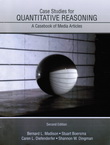
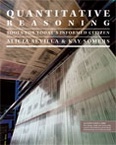
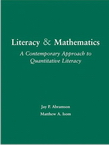
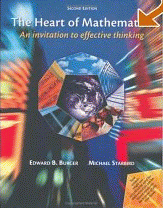
Case Studies for QR (2nd Ed)
Case Studies for Quantitative Reasoning (2nd ed.) by Madison, Boersma, Diefenderfer and Dingman. A case book of news stories.
Topics:
- Numbers and Quantities
- Percent and % change
- Measurement and Indices
- Linear and Exponential growth
- Graphical Interpretation and Production
- Counting, Probability, Odds & Risk
Quantitative Literacy: Thinking Between the Lines. Table of Contents. 2017 3rd edition. By Crauder
Quantitative Reasoning: Tools for Today's Informed Citizen
by Alicia Sevilla and Kay Somers (Moravian College). Available from Key Publishing, Springer and Amazon. Press Release
Topics:
-
Numerical Reasoning
- Organizing Information Pictorially Using Charts and Graphs
- Bivariate Data
- Graphs of Functions
- Multiple Variable Functions
- Proportional, Linear, and Piecewise Linear Functions
- Modeling with Linear and Exponential Functions
- Logarithms and Scientific Notation
- Indexes and Ratings
- Personal Finances
- Introduction to Problem Solving
-
Logical Reasoning
- Decision Making
- Inductive Reasoning
- Deductive Reasoning
- Apportionment
- More on Problem Solving
-
Statistical Reasoning
- Averages and Five-Number Summary
- Standard Deviation, Z-score and Normal Distributions
- Basics of Probability
- Conditional Probability and Tables
- Sampling and Surveys
- More on Decision Making
The need for quantitative reasoning courses has never been stronger: Citing a recent study funded by the Pew Charitable Trusts, the Associated Press reported in 2006 that more than half of the nation’s students at four-year colleges and universities “lack the literacy to handle complex, real-life tasks” such as understanding credit card offers, balancing checkbooks, and computing restaurant tips.
Quantitative Reasoning: Tools for Today’s Informed Citizen helps students connect mathematics in the classroom with applications in the real world. Through a series of hands-on activities and explorations, the text empowers students by teaching them to apply quantitative reasoning skills to make informed decisions in their daily lives. Authors Alicia Sevilla and Kay Somers developed this engaging, activity-based text for students enrolled in an introductory-level, problem-based general education quantitative reasoning course, often called Quantitative Reasoning, Quantitative Literacy, Statistical Reasoning, Statistical Literacy, (Mathematical) Problem Solving, or Liberal Arts Mathematics. At many colleges and universities, this course satisfies a general education requirement in quantitative reasoning.
Literacy & Mathematics: A Contemporary Approach to Quantitative Literacy
by Jay P. Abramson and Mathew A. Isom, Arizona State University. (1st ed. 2005).
Table of Contents by Chapter and Page Number
| 1. | Number Sense | |
| Intro | 1 | |
| Geology: Vastness of Time | 2 | |
| Astronomy: Enormity of Space | 4 | |
| Time and Again, Number Sense | 10 | |
| Set Theory (Well-defined, Cardinal Number, Union, Intersection) | 15 | |
| World of Numbers (Integer, Rational & Real) | 19 | |
| Multiplication Principle (Factorial) | 26 | |
| Permutations and Combinations | 28 | |
| 2. | Probability | |
| Intro | 37 | |
| Introduction to Probability, Coincidences (Conspiracy, Numerology, Sports, Politics) | 41 | |
| Determining the Reasonability of the Media Statistics | 52 | |
| Probability. 2C Probability: Independent and Dependent Events | 57 | |
| Probability Using Counting Theory | 60 | |
| The Binomial Probability Profile | 64 | |
| Conditional Probability | 69 | |
| Bayes Theorem | 73 | |
| Expected Values | 77 | |
| 3. | Statistics | |
| Intro | 83 | |
| Causation and Correlation | 85 | |
| Circle Graphs | 91 | |
| Measure of Central Tendency | 100 | |
| Standard Deviation and Normal Distribution (z-score) | 105 | |
| Standard Deviation | 113 | |
| 4. | Rates of Change | |
| Intro: Numerical versus Percentage Growth | 125 | |
| Linear versus Exponential Growth | 133 | |
| Linear Models | 135 | |
| Exponential Models | 148 | |
| Local Rates of Change | 154 | |
| World Population and Sustainability (Logistic Curves and Population Collapse) | 161 | |
| Concavity | 168 | |
| 5. | Finance | |
| Intro | 173 | |
| Effective Rates, Simple Interest, Compound Interest | 174 | |
| Compound Interest | 181 | |
| Annual Yield | 184 | |
| Annuity | 187 | |
| Different Payment and Interest Conversion Periods | 197 | |
| The Mortgage Payment Equation | 198 | |
| 6. | Geometry | |
| Intro | 203 | |
| Two Dimensional Geometric Figures | 204 | |
| Three Dimensional Geometric Figures | 210 | |
| Real Estate Math | 225 | |
| Trigonometry | 228 | |
| Right Triangle Applications | 231 | |
| 7. | Logic | |
| Intro | 235 | |
| Inductive Reasoning | 237 | |
| Deductive Reasoning | 241 | |
| Symbolic Logic | 244 | |
| Quantifiers | 245 | |
| Connectives | 249 | |
| Truth Tables (Bi-conditional, Common Negations) | 251 | |
| Arguments | 257 | |
| Fallacy | 261 |
The Heart of Mathematics: An invitation to effective thinking (Hardcover)
by Edward B. Burger, Michael Starbird. Key College Press; 2nd Edition (August 18, 2004).
Book Description: The Heart of Mathematics addresses the big ideas of mathematics (many of which are cutting edge research topics) in a non-computational style intended to be both read and enjoyed by students and instructors, as well as by motivated general readers. It features an engaging, lively, humorous style full of surprises, games, mind-benders, and all without either sacrificing good mathematical thought or relying on mathematical computation or symbols.
The authors are award-winning authors, holding awards such as: Distinguished Teaching Award (Burger, from the Mathematical Association of America); Chauvenet Prize (the best expository mathematics writer in the world, Burger, from the MAA) and many others.
- Fun and Games (An Introduction to Rigorous Thought)
- Silly Stories Each with a Moral (Conundrums that evoke Techniques of Effective Thinking)
- Nudges (Leading Questions and Hints for Resolving the Stories)
- The Punch Lines (Solutions and Further Commentary)
- From Play to Power (Discovering Effective Strategies of Thought for Life)
-
Number Contemplation
- Counting (How the Pigeonhole Principle Leads to Precision Thought Estimation)
- Numerical Patterns in Nature (Discovering the Beauty of the Fibonacci Numbers)
- Prime Cuts of Numbers (How the Prime Numbers are the Building Blocks of All Numbers)
- Crazy Clocks and Checking Out Bars (Cyclical Clock Arithmetic and Bar Codes)
- Public Secret Codes and How to Become a Spy (Encrypting Information Using Modular Arithmetic and Primes)
- The Irrational Side of Numbers (Are There Numbers Beyond Fractions)
- Get Real (The Point of Decimals and Pinpointing Numbers on the Real Line)
-
Infinity
- Beyond Numbers (What Does Infinity Mean?)
- Comparing the Infinite (Pairing Up Collections Via a One-to-One Correspondence)
- The Missing Member (George Canton Answers: Are Some Infinities Larger Than Others?)
- Travels Toward the Stratosphere of Infinities (The Power Set and the Question of the Infinite Galaxy of Infinities)
- Straightening Up the Circle (Exploring the Infinite Within Geometric Objects)
-
Geometric Gems
- Pythagoras and his Hypotenuse (How a Puzzle Leads to a Proof of One of the Gems of Mathematics)
- A View of an Art Gallery (Using Computational Geometry to Place Security Cameras in Museums)
- The Sexiest Rectangle (Finding Aesthetics in Life, Art and Math Through the Golden Rectangle)
- Smoothing Symmetry and Spinning Pinwheels (Can a Floor Be Tiled Without Any Repeating Pattern?)
- The Platonic Solids Turn Amorous (Discovering the Symmetry and the Interconnections Among the Platonic Solids)
- The Shape of Reality? (How Straight Lines Can Bend in Non-Euclidean Geometries)
- The Fourth Dimension (Can You See It?)
-
Contortions of Space
- Rubber Sheet Geometry (Discovering the Topological Idea of Equivalence by Distortion)
- The Band that Wouldn't Stop Playing (Experimenting with the Mŏbius band and Klein Bottle)
- Feeling Edgy? (Exploring Relationships Among Vertices, Edges and Faces)
- Knots and Links (Untangling Ropes and Rings)
- Fixed Points, Hot Loops and Rainy Days (How the Certainty of Fixed Points Implies Certain Weather Phenomena)
-
Chaos and Fractals
- Images (Viewing a Gallery of Fractals)
- The Dynamics of Change (Can Change be Modeled by Repeated Applications of Simple Processes?)
- The Infinitely Detailed Beauty of Fractals (How to Create Works of Infinite Intricacy Though Repeated Processes)
- The Mysterious Art of Imaginary Fractals (Creating Julia and Mandelbrot Sets by Stepping Out in the Complex Plane)
- Predetermined Chaos (How Repeated Simple Processes Result in Utter Chaos)
- Between Dimensions (Can the Dimensions of Fractals Fall between the Cracks?)
-
Taming Uncertainty
- Chance Surprises (Some Scenarios Involving Chance that Confound Our Intuition)
- Predicting the Future in an Uncertain World (How to Measure Uncertainty Using the Idea of Probability)
- Random Thoughts (Are Coincidences as Truly Amazing as They First Appear?)
- Down for the Count (Systematically Counting All Possible Outcomes)
- Collecting Data Rather than Dust (The Power and Pitfalls of Statistics)
- What the Average American Has (Different Means of Describing Data)
- Parenting Peas, Twins and Hypotheses (Making Inferences from Data)
-
Deciding Wisely (Applications of Rigorous Thinking)
- Great Expectations (Deciding How to Weigh the Unknown Future)
- Risk (Deciding Personal and Public Policy)
- Money Matters (Deciding between Faring Well and Welfare)
- Peril at the Polls (Deciding Who Actually Wins an Election)
- Cutting Cake for Greedy People (Deciding How to Allocate Scarce Resources)
Farewell, Acknowledgments (2nd and 1st ed.), Hints and Solutions, Index, Credits.
“The Heart of Mathematics is easily the best liberal-arts math textbook ever written. The authors really understand which math is really beautiful and interesting. … They are pioneers in writing engagingly about mathematics.” — Professor David Kennedy, Granville State College.
[See also Coincidences, Chaos, and All That Math Jazz: Making Light of Weighty Ideas by the same authors. Similar topics but a third the size.]
Environmental Mathematics in the Classroom
by B. A. Fusaro (Editor), P. C. Kenschaft (Editor). MAA (1st ed., 2003).
Book Description: Environmental Mathematics seeks to marry the most pressing challenge of our time with the most powerful technology of our time - mathematics. This book does this at an elementary level and demonstrates a wide variety of significant environmental applications that can be explored without resorting to calculus. Environmental Mathematics in the Classroom includes several chapters accessible enough to be a text in a general education course, or to enrich an elementary algebra course. Ground-level ozone, pollution and water use, preservation of whales, mathematical economics, the movement of clouds over a mountain range, at least one population model and a smorgasbord of 'newspaper mathematics' can be studied at this level and would form a stimulating course. It would prepare future teachers not only to learn basic mathematics, but to understand how they can integrate it into other topics that will intrigue students.
About the Authors:
Ben Fusaro received his PhD from the University of Maryland. He went on to be a Professor Mathematics at the University of South Florida. Queens College (NC) and Salisbury State University. He introduced “Environmental Mathematics,” a liberal arts course, at Salisbury in 1984, and created the Mathematical Modeling Course in 1985. He has been actively involved in organizing workshops, and increasing awareness in the area of environmental mathematics.
Pat Kenschaft's many former books include “Mathematics for Human Survival,” a text for quantitative literacy for college students with all its exercises and examples using numbers from environmental health, and peace issues, and “Winning Women into Mathematics,” published by the MAA. She received her PhD in functional analysis from the University of Pennsylvania, and is currently Professor of Mathematics at Montclair State University.
QUANTITATIVE REASONING WITH MODELS
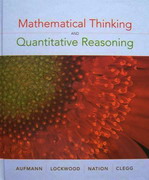
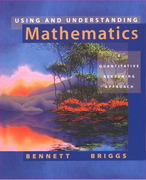
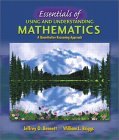
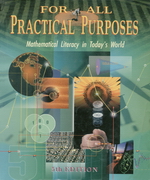
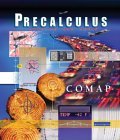
Mathematical Thinking and Quantitative Reasoning Houghton Mifflin Co
by Richard N. Aufmann (Palomar College), Joanne S. Lockwood (New Hampshire Community Technical College), Richard D. Nation (Palomar College) and Daniel K. Clegg (Palomar College). (1st ed. 2008).
“Designed for the non-traditional Liberal Arts course, Mathematical Thinking and Quantitative Reasoning focuses on practical topics that students need to learn in order to be better quantitative thinkers and decision-makers. The author team's approach emphasizes collaborative learning and critical thinking while presenting problem solving in purposeful and meaningful contexts.”
CONTENTS
- Problem Solving
- Inductive and Deductive Reasoning
- Problem-Solving Strategies
- Problem Solving Using Sets
-
Logic and its Applications
- Logic Statements and Quantifiers
- Truth Tables and Applications
- The Conditional and Related Statements
- Arguments
- Euler Diagrams
-
Algebraic Models
- First-Degree Equations and Formulas
- Rate, Ratio, and Proportion
- Percent
- Direct and Inverse Variation
-
Measurement and Geometric Models
- The Metric System
- The U.S. Customary System
- Basic Concepts of Euclidean Geometry
- Perimeter and Area of Plane Figures
- Properties of Triangles
- Volume and Surface Area
- Introduction to Trigonometry
-
Linear Models
- Rectangular Coordinates and Functions
- Properties of Linear Functions
- Finding Linear Models
- Linear Regression and Correlation
-
Nonlinear Models
- Introduction to Nonlinear Functions
- Exponential Functions
- Logarithmic Functions
-
The Mathematics of Finance
- Simple Interest
- Compound Interest
- Credit Cards and Consumer Loans
- Stocks, Bonds, and Mutual Funds
- Home Ownership
-
Probability and Statistics
- Counting Methods
- Introduction to Probability
- Measures of Central Tendency
- Measures of Dispersion
- Measures of Relative Position
- Normal Distributions
- Inferential Statistics
-
Apportionment and Voting
- Introduction to Apportionment
- Introduction to Voting
- Weighted Voting Systems
-
The Mathematics of Graphs
- Traveling Roads and Visiting Cities
- Efficient Routes
- Map Coloring and Graphs
Web Appendix: Algebra Review (Available only online at this textbook's Online Study Center)
Using and Understanding Mathematics: A Quantitative Reasoning Approach
by Jeffrey O. Bennett, William L. Briggs (3rd ed. 2004).
From Book News, Inc. “Aimed at students majoring in nonmathematical fields—particularly those who feel some anxiety about math—this textbook focuses on the practical applications of mathematics in college, career, and life. Although not remedial in nature, the text is suitable for students with a wide range of mathematical backgrounds. The use of critical thinking skills is emphasized throughout. Topics include, for example, income taxes, statistical reasoning, mathematics and music, voting theory, and exponential population growth.”
Table of Contents (by Chapter)
- Principles of Reasoning
- The Forces of Persuasion, An Overview of Common Fallacies
- Propositions: The Building Blocks of Arguments
- Arguments: Deductive and Inductive
- Analyzing Real Arguments
-
Statistical Reasoning
- Fundamentals of Statistics
- Should you believe a Statistical Study?
- Basic Statistical Graphs
- Graphs in the Media
- Causal Connections
-
Problems Solving Tools
- Using Unit Analysis
- Systems of Standardized Units
- The Process of Problem Solving
-
Numbers in the Real World
- Concepts of Numbers
- Uses and Abuses of Percentages
- Putting Numbers in Perspective
- Dealing With Uncertainty
-
Financial Management
- The Power of Compound Interest
- Savings Plans (Annuities)
- Loan Payments, Credit Cards and Mortgages
- Income Taxes
- Investments
-
Modeling our World
- Functions: The Building Blocks of our Mathematical Models
- Linear Graphs and Modeling
- Formulas as Models
-
Exponential Growth and Decay
- Exponential Astonishment
- Doubling Time and Half Life
- Exponential Modeling
- Real Population Growth
-
Probability: Living with the Odds
- Principles of Counting
- Fundamentals of Probability
- Combining Probabilities
- The Law of Averages
- Probability, Risk and Coincidence
-
Putting Statistics to Work
- Characterizing Data
- Linear Regression Models
- Statistical Inference
- Sample Issues in Statistical Research
-
Mathematics and the Arts
- Fundamentals of Geometry
- Mathematics and Music
- Perspective and Symmetry
- Proportion and the Golden Ratio
- Fractal Geometry
-
Discrete Mathematics in Business and Society
- Network Analysis
- The Traveling Salesman Problem
- Project Design
- Voting. Does the Majority Always Rule?
- Theory of Voting
-
The Power of Numbers. A few more topics
- Balancing the Federal Budget
- Energy: Our Future Depends on it
- Density and Concentration
- Logarithmic Scales: Earthquakes, Sounds and Acids
Essentials of Using and Understanding Mathematics: A Quantitative Reasoning Approach
by Bennett and Briggs (1st ed. 2002).
“This premiere text serves the newly emerging Quantitative Reasoning/Literacy Course, as well as an alternative approach for Liberal Arts/Survey Math. It provides a legitimate alternative for non-quantitative majors, helping to reduce math anxiety and emphasizing practicality. It's the mathematics you need for college, career, and life. Essentials of Using and Understanding Mathematics is a condensed version of the full book [see above]. It is designed for those who see only the ‘core’ material for their courses.”
For All Practical Purposes: Mathematical Literacy in Today's World
by COMAP (1988, 6th ed. 2002)
“COMAP — the Consortium of Mathematics and Its Applications — is a group of mathematicians and educators dedicated to the improvement in the teaching of math by demonstrating to students how math is a crucial part of the world around us. They believe that students must cultivate an understanding of math — develop mathematical literacy — if they are to succeed in a society that is increasingly process-driven and where problem-solving skills are increasingly important.”
- Management Science
- Street Networks
- Visiting Vertices
- Planning & Scheduling
- Linear Programming
-
Statistics, The Science of Data
- Producing Data
- Exploring Data
- Probability
- Statistical Inference
-
Coding Information
- Identification Numbers
- Transmitting Numbers
-
Social Choice and Decision Making
- Social Choice, The Impossible Dream
- Weighted Voting Systems
- Fair Division
- Apportionment
- Game Theory, The Mathematics of Competition
-
On Size and Shape
- Growth and Form
- Symmetry and Patterns
- Tilings
-
Modeling in Mathematics
- Logic and Modeling
- Consumer Finance Models
Pre-Calculus: Modeling Our World
by COMAP (2001)
Quantitative Reasoning with Algebra


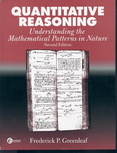

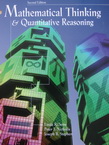
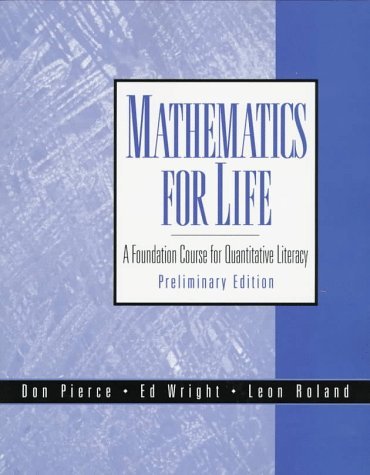
Quantitative Reasoning and the Environment
by Greg Langkamp and Joseph Hull (1st ed. 2006). AMATYC talk
Table of Contents:
-
Essential Numeracy
- Measurement and Units Mercury and the Inuit of Greenland, Measuring, Accuracy and Precision of Measurement, Estimation and Approximation, Units of Measurement, Unit Conversion, Compound Units, Units in Equations and Formulas, Unit Prefixes, Scientific Notation and Order of Magnitude, Powers of 10 and Logarithms, Logarithmic Scales
- Ratios and Percentages Ratios, Normalization, Percentage as a Type of Ratio, Parts per Thousand, Parts per Million and Parts per Billion, Percentage as a Measure of Change, Percentage Difference and Percentage Error, Proportions, Probability, Recurrence Interval
- Graphs and Charts Pie Charts, Bar Charts, Frequency Histograms, Using Technology: Histograms, Relative Frequency Histograms, Scatterplots, Using Technology: Scatterplots, Line Graphs
-
Function Modeling
- Linear Functions and Regression Modeling with Linear Functions, Units of Measure in Linear Equations, Dependent versus Independent Variables, Graphing Linear Equations, Using Technology: Graphs and Tables, Approximating Almost-Linear Data Sets, straightedge method, least squares regression, Using Technology: Linear Regression, The Correlation Coefficient “r,” Using Technology: The Correlation Coefficient, Correlation Fallacies.
- Exponential Functions and Regression Exponential Rates and Multipliers, The General Exponential Model, Finding Exponential Functions—the More General Case, Solving Exponential Equations, Doubling Times and Half-Lives, Approximating Almost-Exponential Data Sets, straightedge method, least squares regression, Using Technology: Exponential Regression.
- Power Functions Basic Power Functions, Solving Power Equations, Approximating Almost-Power Law Data Sets, straightedge method, least squares regression, Using Technology: Power Regression, Power Law Frequency Distributions, Power Law Distributions and Fractals, Recurrence Intervals.
-
Difference Equation Modeling
- Introduction to Difference Equations Sequences and Notation, Modeling with Difference Equations, Linear Difference Equations, Exponential Difference Equations, Why Use Difference Equations?, Affine Difference Equations, Using Technology: Difference Equations.
- Affine Solution Equations and Equilibrium Values The Solution Equation to the Affine Model, Equilibrium Values, Classification of Equilibrium values, Revisiting the Affine Solution Equation.
- Logistic Growth, Harvesting and Chaos Modeling Logistic Growth with Difference Equations, Logistic Equilibrium Values, Harvest Models, Periodic Behavior, Chaotic Behavior.
- Systems of Difference Equations Systems Modeling, Using Technology: Systems of Difference Equations, Exponential Change and Stable Age Distributions, What Else Besides Populations?
-
Elementary Statistics
- Fundamentals of Statistics Measures of Center and Other Descriptive Statistics, Weighted Means, Quartiles and the 5 Number Summary, Boxplots, Using Technology: Finding Descriptive Statistics, Shape of a Data Set, Using Technology: Histograms, A Skew Formula, Comparing the Mean and Median, Sampling.
- Standard Deviation Standard Deviation, Calculating Position Using Z-scores, Outliers, Chebychev's Rule, Normal Distributions, The Empirical Rule.
- Normal Distribution The Standard Normal Distribution, Transformations to Normal, Confidence Intervals.
Book Description:
An introductory quantitative math book with an environmental theme. The emphasis of this text is on analyzing real environmental information and problems, using mathematics accessible to students with an intermediate algebra background. Students using this text will develop mathematical (and environmental) literacy as they model natural processes using algebraic, graphical and numerical methods, and analyze data quantitatively to assist in objective decision making.
The textbook is comprised of 4 principal sections: (1) basic numeracy; (2) function modeling; (3) difference equation modeling, and; (4) elementary statistics. Furthermore, this textbook combines both a reform and traditional approach. Traditional in that each chapter presents introductory material, worked examples, multiple student problems, and solutions to odd exercises. It is reform in that it investigates material through a synthesis of algebraic, graphical, numerical and verbal approaches.
Explorations in College Algebra
by Linda Almgren Kime, Judith Clark, Beverly K. Michaelson (3rd ed. 2005).
Table of Contents:
-
Making Sense of Data and Functions
- Describing Single-Variable Data
- Describing Relationships between Two Variables
- An Introduction to Functions
- Visualizing Functions
-
Rates of Change and Linear Functions
- Average Rates of Change
- Change in the Average Rate of Change
- The Average Rate of Change is a Slope
- Putting a Slant on Data
- Linear Functions: When Rates of Change are Constant
- Visualizing Linear Functions
- Finding Graphs and Functions of Linear Equations
- Special Cases
-
Constructing Linear Models for Data
An Extended Exploration
Using U.S. Census Data
Summarizing the Data: Regression Lines
Interpreting the Regression Lines: Correlation vs. Causation
-
When Lines Meet: Linear Systems
- Systems of Linear Equations
- Finding Solutions to Systems of Linear Equations
- Linear Inequalities: Reading Between the Lines
- Systems with Piecewise Linear Functions: Tax Plans
-
The Laws of Exponents and Logarithms: Measuring the Universe
- The Numbers of Science: Measuring Time and Space
- Positive Integer Exponents
- Negative Integer Exponents
- Converting Units
- Fractional Exponents
- Orders of Magnitude
- Logarithms Base 10
-
Growth and Decay: An Introduction to Exponential Functions
- Exponential Growth
- Linear vs. Exponential Functions
- Exponential Decay
- Visualizing Exponential Functions
- Exponential Functions: A Constant Percentage Change
- Examples of Exponential Growth and Decay
- Semi-Log Plots of Exponential Functions
-
Logarithmic Links: Logarithms and Exponential Functions
- Using Logarithms to Solve Exponential Functions
- Base e and Continuous Compounding
- The natural Logarithm
- Logarithmic Functions
- Transforming Exponential Functions to Base e
- Using Semi-Log Plots to Construct Exponential Models for Data
-
Power Functions
- The Tension Between Surface Area and Volume
- Direct Proportionality: Power Functions with Positive Powers
- Visualizing Positive Integer Powers
- Comparing Power and Exponential Functions
- Inverse Proportionality: Power Functions with Negative Integer Powers
- Visualizing Negative Integer Power Functions
- Using Logarithmic Scales to find the Best Functional Model
-
Quadratics, Polynomials and Beyond
- An Introduction to Quadratic Functions
- Finding the Vertex: Transformations of Y = X2
- Finding the Horizontal Intercepts
- The Average Rate of Change of a Quadratic Function
- An introduction to Polynomial Functions
-
New Functions from Old
An Extended Exploration: The Scientific Method
The Free-Fall Experiment
Collecting and Analyzing Data from a Free-Fall Experiment
Book Description
Explorations in College Algebra, 3/e and its accompanying ancillaries are designed to make algebra interesting and relevant to the student. The text adopts a problem-solving approach that motivates students to grasp abstract ideas by solving real-world problems. The problems lie on a continuum from basic algebraic drills to open-ended, non-routine questions. The focus is shifted from learning a set of discrete mathematical rules to exploring how algebra is used in the social, physical, and life sciences. The goal of Explorations in College Algebra, 3/e is to prepare students for future advanced mathematics or other quantitatively based courses, while encouraging them to appreciate and use the power of algebra in answering questions about the world around us.
Explorations in College Algebra was developed by the College Algebra Consortium based at the University of Massachusetts, Boston and funded by a grant from the National Science Foundation. The materials were developed in the spirit of the reform movement and reflect the guidelines issued by the various professional mathematics societies (including AMATYC, MAA, and NCTM).
Quantitative Reasoning: Understanding the Mathematical Patterns of Nature
by Frederick P. Greenleaf (2nd ed., 2000)
To Students: “This is not a math course in the familiar sense.” The purpose of this course is “to show why mathematics is necessarily the language of science. The math topics we cover are fairly elementary, but our use of them is not. In order to understand how scientists think, you have to learn to think for yourself using the tools that mathematics provides. This course aims to show how one can take real world problems, translate them into mathematics, and solve them.” “Quantitative Reasoning explores the mathematical tools you will need to understand why mathematics became the language of science.” To Instructors: These materials “address the issue of promoting quantitative literacy among the vast majority of college students who do not intend to major in mathematics of the sciences. They were also designed to be a vehicle for enhancing math and science backgrounds of the non-specialist K-12 teachers in training.”
-
Measuring Things in the Real World
What is Mathematics?
Real World Measurements: Dealing With Units
The Art of Making Estimates
-
Growth and Decay Phenomena
Geometric Progressions and Growth
Growth of Money, Present Value, Exponential & Logarithmic Functions
-
How Big is the Sun, How Far are the Stars?
Scaling Transformations, Size & Form
Angles & Size of the Earth
Measuring the Inaccessible: Triangulation, Angular Diameter and the Resolving Power of the Eye
Next Steps in the Cosmic Distance Ladder, Method of Std. Candles
-
Intro to Probability and Statistics:
Counting Problems
Mathematical Probability
Independent Events
Probability vs. Statistics
Appendix A: Review of Exponent Laws; Basic Use of Calculators
Appendix B: Useful Data & Formulas
Appendix C: Answers to Odd Problems
Quantitative and Qualitative Reasoning Skills
by James F. Burkhart (2nd ed., 1999)
-
Understanding Numbers and Magnitudes
Review of Basic Mathematics
The Number Line
Neat Trick for Adding and Subtracting
Fraction
The Theory of Bases
-
Algebraic Skills
Exponential Notation
Scientific Notation
Significant Figures
Arithmetic Operations with Exponentials
The Associative, Distributive and Commutative Properties
Factoring
Graphing
Another look at Some Functions
Solving for the Unknown
-
Statistics in Everyday Life
An Overview
Making a Picture of the Data
Statistics
The Normal Curve
The Standard Normal Curve
Means Testing
-
Fun with Logic
Arguments
Fallacies
Converting Statements to Symbols
Truth Tables
Mathematical Thinking & Quantitative Reasoning
by Linda R. Sons, Peter J. Nicholls, Joseph B. Stephen (2nd ed. 1998)
-
Statistics
- Graphical Presentations of Data
- Measures of Central Tendency and Dispersion
- The Normal Curve
- Sampling and Count-Recount Technique
- Probability
- The Nature of Statistical Testing
-
Logical Statements and Arguments
- Logical Statements, Conjunctions and Disjunctions
- Implication Statements and Logical Equivalence
- Valid Arguments and Logical Fallacies
- Survey Analysis
-
Geometry in Problem Solving
- Graphical Solution of polynomial equations and systems of equations
- Graphical Solution of Systems of Inequalities
- Spatial Relationships
-
Estimation, Approximation and Judging the Reasonableness of Answers
- Review of the algebraic solution of polynomial equations and systems of linear equations
- Inequalities — Maxima and Minima
- The Function Concept and the Average Rate of Change
- Sequential Thinking and the Formulation of Algorithms
- Error Analysis
-
Problem Solving
- Strategies in Problem Solving
- Using the Hand-held Calculator/Personal Computer
- Personal Business Applications
- Other Applications
- Chapter Objectives
- Normal Curve Percentages
- Random Digit Table
- Chi-Square Probability Distribution,
- Formulas
- Algebraic Background
- Calculators
- Projects
Mathematics for Life: A Foundation Course for Quantitative Literacy
by Don Pierce, Ed Wright, Leon Roland (1997)
-
Literacy
- Economic Value
- Social Value
- Necessary Skills
- Course Mechanics
- Group Dynamics
-
Computers & Operating Systems
- History
- Computing and Operating Systems
-
Learning and Working in Groups
- What is Learning?
- Components of Knowledge
- Levels of Learning
- How We Learn
- Natural Abilities
- Thinking Skills
- Learning in Teams
- Roles within Teams
- Team Strategies
-
Mathematics: A Historical Approach
- Roots of Civilization
- Numeral Systems
- Basic Operations
- Arithmetic
- Modern Numeral Systems
-
Algebra and Spreadsheets
- Egyptian Algebra
- Babylonian Algebra
- Greek Algebra
- Indian Algebra
- Language of Algebra
- Number Systems
- Spreadsheets
- Connecting Algebra to Spreadsheets
- Graphing Functions using Spreadsheets
-
Statistics
- History
- Statistics Today
- Descriptive Statistics
- Statistics: Uses and Abuses
-
Apportionment
- History
- Basic Terminology
- Methods of Apportionment
-
Functions and Modeling
- Basic Units of Measurement
- Modeling the Heavens
- Linear Models
- Exponential Models
- Relations and Functions
- Curve Fitting
-
Probability and Inferential Statistics
- Empirical Probability
- Games of Chance
- Binomial Distribution
- Normal Distribution
- Sampling Distribution of a Statistic
- Hypothesis Testing
- Small Samples
-
Internet Essentials
- History
- Electronic Mail
- Finding Information on the Web
- Surfing Cyberspace
- Internet Glossary
Quantitative Literacy: Course Manual
by Gialamos 4th ed (1999) [Out of Print]
Quantitative Literacy: Mathematics for Citizenship in the 21st Century
by Bennett (1996) [Out of Print]
Quantitative Reasoning: Mathematics for Citizens in the 21st Century
by Bennett, Briggs and Morrow (1996)
Beyond Problem Solving & Comprehension: An Exploration of Quantitative Reasoning
by Whimbey & Lochhead (1984)
Mathematics for your world: The application of quantitative reasoning to day-to-day problems
by Growney (1982)
MODERN MATHEMATICS / MATH FOR LIBERAL ARTS
College-Algebra Based/Focused
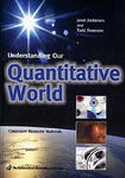
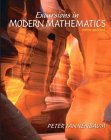
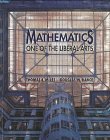
Understanding our Quantitative World
by Janet Anderson and Todd Swanson (1st ed. 2004) Preface and Detailed Table of Contents
The perfect text for a general education mathematics course.
This text is intended for a general education mathematics course. The authors focus on the topics that they believe students will likely encounter after college. These topics fall into the two main themes of functions and statistics. After the concept of a function is introduced and various representations are explored, specific types of functions (linear, exponential, logarithmic, periodic, power, and multivariable) are investigated. These functions are explored symbolically, graphically, and numerically and are used to describe real world phenomena. On the theme of statistics, the authors focus on different types of statistical graphs and simple descriptive statistics. Linear regression, as well as exponential and power regression, is also introduced. Simple types of probability problems as well as the idea of sampling and confidence intervals are the last topics covered in the text.
The text is written in a conversational tone. Each section begins by setting the mathematics within a context and ends with an application. The questions at the end of each section are called Reading Questions because students are expected to be able to answer most of these after carefully reading the text. Activities and Class Exercises are also found at the end of each section. These activities are taken from public sources such as newspapers, magazines, and the World Wide Web. Doing these activities demonstrates to students that they can use mathematics as a tool in interpreting quantitative information they encounter outside of the academy. The course is designed to allow students to spend most of their time in class working in groups on the activities. Rather than having students passively listen, this approach requires students to read, discuss, and apply mathematics. The text assumes that students will have access to some type of technology such as a graphing calculator.
Table of Contents (by Chapter)
- Functions
- Graphical Representations of Functions
- Applications of Data
- Describing Data (Mean, Median and Standard Deviation)
- Displaying Data
- Multivariable Functions and Contour Diagrams
- Linear Function
- Exponential Functions
- Exponential Functions
- Logarithmic Functions
- Periodic Functions
- Power Functions
- Probability
- Random Samples
Appendix: Instructions for the TI-83 Graphing Calculator
Excursions in Modern Mathematics
by Peter Tannenbaum (5th ed., 2003)
Book Description: “This collection of ‘excursions’ into modern mathematics is written in an informal, very readable style, with features that make the material interesting, clear, and easy-to-learn. It centers on an assortment of real-world examples and applications, demonstrating attractive, useful, and modern coverage of liberal arts mathematics. The book consists of four independent parts, each consisting of four chapters—1) Social Choice, 2) Management Science, 3) Growth and Symmetry, and 4) Statistics. For the study of mathematics.”
Preface of 1998 edition: “We have made a concerted
effort to introduce the reader to a view of mathematics that is entirely
different from the traditional algebra-geometry-trigonometry-finite math
curriculum that so many people have learned to dread, fear and
occasionally abhor. The notion that general education mathematics
must be dull, unrelated to the real world, highly technical and deal
mostly with concepts that are historically ancient is totally unfounded.
Applicability: The connection between the mathematics presented
here and down-to-earth, concrete real-life problems is direct and
immediate.”
“Accessibility: We have found Intermediate Algebra to
be an appropriate and sufficient prerequisite. Aesthetics: A
fundamental objective of this book is to develop an appreciation for the
aesthetic elements of mathematics.”
Modern Mathematics
by Ruric E. Wheeler, Ed R. Wheeler (2001)
Book News: “Emphasizing problem-solving skills, this introductory textbook contains 14 chapters covering: critical thinking; logic; sets, relations, and functions; whole numbers and numeration; integers and number theory; rational numbers; real numbers; consumer mathematics; probability; statistics; informal geometry; measurement and the metric system; transformations; and algebra, geometry, and graph theory.”
The Mathematical Tourist : New and Updated Snapshots of Modern Mathematics
by Ivars Peterson (1998/1988)
Modern Mathematics for Elementary School Teachers
by Ruric E. Wheeler, Ed R. Wheeler (9th ed., 1995)
Concepts of Modern Mathematics
by Ian Stewart (1995)
MATHEMATICS FOR THE LIBERAL ARTS
Mathematics for Liberal Arts
by Richman, Walker, Wisner, Brewer (4th ed., 2002)
Back Cover: “This book communicates the spirit of mathematics by means of simple ideas and problems, emphasizing exploration rather than drill. Its accessible approach encourages appreciation of mathematics and is ideal for readers with weak backgrounds, yet is interesting enough to involve anyone. Counting. Probability. Statistics. Geometry. Logic. Exponential Growth. Averages. Natural Numbers. Changing Bases. Clock Arithmetic. Secret Writing. Infinite Sets. Number Theory Selections. For anyone who needs to learn or review basic math concepts.”
Mathematics: A Liberal Arts Approach
by Irving Allen Dodes (2000)
Mathematics for the Liberal Arts Student
by Wisner, Walker Brewer, Richman (1st ed., 1999)
Mathematics for the Liberal Arts II
by Miller, Heeren, et al. (1999)
Mathematics for the Liberal Arts I
by Charles D. Miller, Vern E. Heeren, E. John Hornsby (1999)
Math for Liberal Arts
by Richman (1998)
Mathematics: One of the Liberal Arts
by Thomas J. Miles, Douglas W. Nance (1st ed., 1997)
Book Description: “This text includes a history of math and covers logic, computing, finance, and geometry. The numerous exercise and problem sets, including writing exercises, provide non-majors with a thorough foundation of mathematics.”
Liberal arts mathematics
by Joseph Newmark (1992*)
A Mathematics Sampler: Topics for the Liberal Arts
by William P. Berlinghoff, Kerry E. Grant (3rd ed., 1992*)
Instructors Guide to Math Liberal Arts
by Johnny Lott, Richard Billstein (1986*)
FUNDAMENTAL CONCEPTS OF MATHEMATICS
Pathways to College Mathematics. Table of Contents
(2020) By D. Franklin Wright
Introduction to Mathematical Thinking : The Formation of Concepts in Modern Mathematics (Popular Science)
by Friedrich Waismann (2003; reproduction of 1959 edition)
Foundations and Fundamental Concepts of Mathematics
by Howard Whitley Eves (3rd ed., 1997)
* Special Order or Out Of Print/Limited Availability
